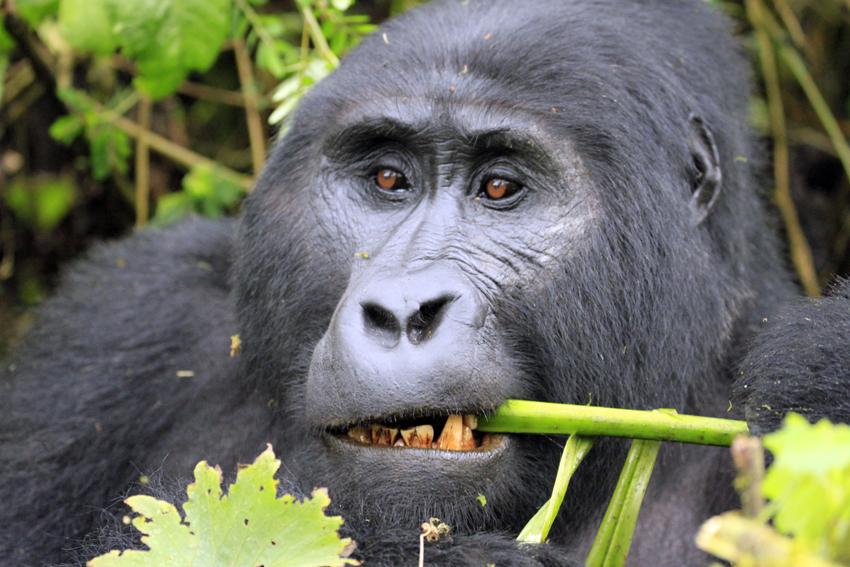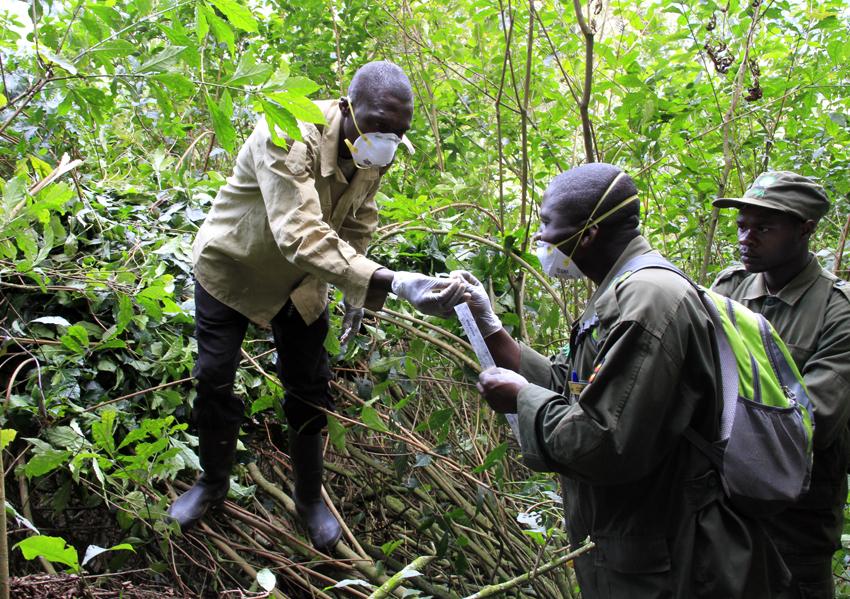Gorilla trekking in Uganda: Learning to track the animals thanks to a new government programme
Gorilla trekking in Uganda has traditionally been an hour-long meet-and-greet, but a new programme allows visitors to track the animals too. Sue Watt joins the trail

Your support helps us to tell the story
From reproductive rights to climate change to Big Tech, The Independent is on the ground when the story is developing. Whether it's investigating the financials of Elon Musk's pro-Trump PAC or producing our latest documentary, 'The A Word', which shines a light on the American women fighting for reproductive rights, we know how important it is to parse out the facts from the messaging.
At such a critical moment in US history, we need reporters on the ground. Your donation allows us to keep sending journalists to speak to both sides of the story.
The Independent is trusted by Americans across the entire political spectrum. And unlike many other quality news outlets, we choose not to lock Americans out of our reporting and analysis with paywalls. We believe quality journalism should be available to everyone, paid for by those who can afford it.
Your support makes all the difference.“Everything about Rushenya is big: his head, his arms, his feet, and especially his bum.” Augustine Muhangi doesn’t stand on ceremony as he gives a running commentary about the 250kg silverback gorilla we’re tracking. In turn, Rushenya waddles away, affording us a perfect view of that colossal backside.
Unlike most mountain gorillas met by tourists in western Uganda’s Bwindi Impenetrable National Park, Rushenya hasn’t encountered many humans. His group, Bikingi, roams the Rushaga area in Bwindi’s southern sector, and is only semi-habituated – used to trackers and rangers but not to strangers or tourists.
Although the 400 or so gorillas in this dense 321sq km forest are all essentially wild, some are wilder than others. The last family I was tracking – the Mubare family in the park’s northern sector – were completely unperturbed by our group of eight’s presence. Kanyonyi, the silverback, had almost brushed against my thighs as he ambled past; others were completely relaxed as they munched on stalks, played in trees and chilled out on cushions of ferns.
But being in the Bikingi’s presence has a definite edge.
Gorilla encounters here in Bwindi have traditionally been limited to one hour: magical yet fleeting. They’re costly, too, at $600 (£480) a head – though the fees are ploughed back into conservation in this park that’s home to half the world’s critically endangered mountain gorillas.
But last year, the park introduced something a little different.
“Normally, trackers find the gorillas before the visitors arrive, so the groups can go straight to them, have their hour with them, and go away,” says Pontius Ezuma, Bwindi’s conservation manager. “We wanted to offer something more enriching – to show what tracking actually means. Things like gorilla behaviour, what nests look like, finding their trail.”
The new visit, run by Uganda Wildlife Authority in Rushaga, the southern area of the park, is a four-hour “gorilla habituation experience”. Groups are limited to just four guests, and permits cost $1,500 each.

You don’t necessarily get more time with the gorillas themselves; instead, you join trackers right from the start and find the families with them. Depending on how quickly you find them, however, it's possible to get two, or even three hours with them. As well as providing you with the experience of a lifetime, the visit helps the gorillas too, allowing animals like Rushenya to get used to human presence.
We’d already walked for three hours along the Ivy Trail to reach the south, starting at Buhoma, where we’d spent the night, and passing through fairytale rainforest with giant ferns, vibrant birdsong and monkeys swinging in the shadows. Our bed for the night was Nkuringo, the nearest village for Rushaga with two lodges: Nkuringo Bwindi Gorilla Lodge, a welcoming home-from-home perched on Nteko Ridge, and the high-end, community-owned Clouds Mountain Gorilla Lodge, overlooking the Virunga Volcanoes.
At 7am the next day, we set off with Augustine (our guide), porters and tracker to where they left the Bikingi group the night before. It's only when we reach that point that the four-hour clock starts ticking, starting with a crash course in tracking. Discarded leaves, stems stripped of foliage, bent vegetation and knuckle prints in the mud are tell-tale signs of the gorillas’ trail, Augustine explains. But it’s the acrid stench of urine that finally reveals their nests.
Gorillas build new nests every night, we learn, leaving a mine of information for trackers. Augustine and his team don facemasks and latex gloves to examine “mattresses” of leaves and branches perched on top of shrubs. Rushenya’s bed is easily identified by its vast size and silver hairs; a small turd next to a larger pile reveals the nest of a mother and baby. Diligently recording everything on data sheets, the team collect samples for analysis. Then it’s straight on with the search.

It takes around three years to habituate gorillas. Over 18 months of daily visits, the Bikingi group have become accustomed to their trackers, but are still wary, particularly with new people. “Remember they might charge,” says Geoffrey Twinomuhangi from UWA. “Copy their movements. Crouch down. If they eat grass, pretend to eat grass. But don’t beat your chest: that’s their sign of supremacy. Whatever you do, don’t run.”
Suddenly there’s Rushenya, munching stalks in a clearing about 12m away. The trackers cough softly – the sound of contentment in gorilla language. “Speak to him,” Augustine whispers. “Let him know you’re a friend.” Nervously, I try a quiet, guttural rumble that tickles my throat. When he responds, grunting deeply, I feel shivers down my spine.
Rushenya and his family – four females, three toddlers and a three-week old baby – are constantly on the move, and both the purpose and the challenge of habituation is to stay with them and keep in their vision no matter what. We hurtle after them, battling through tangled jungle, crawling through bushes and scurrying up and down near-vertical slopes of loose earth, wet leaves and slippery vegetation. Gradually, we narrow our distance until we’re a mere seven metres apart. Big Daddy Rushenya eats incessantly; youngsters play tag in the trees, laughing and smiling; mums keep a watchful eye on them and on us.
Suddenly, a female carrying her three-week old baby tumbles down the slope, landing between the silverback and me. Rushenya swings into action, running towards us, almost shouting a reverberating “uh uh” noise. Thankfully, we remember our briefing. We avert our eyes and crouched submissively. He freezes in front of us, all 40-odd stone of him, sussing out the situation... and then slowly moves on. It felt like forever but must only have been seconds. “He was just warning us, protecting the baby,” Augustine reassures us.
Whether you have one hour or four with these majestic, vulnerable creatures, it will never be enough, and all too soon our time is up. As is Rushenya’s – as we turn to leave, he’s already heading deep into the forest. For Augustine and his crew, tomorrow is another day.

Travel Essentials
Getting there
Steppes Travel (www.steppestravel.co.uk; 01285 601050) offer a 7 day trip from £5,695 per person based on two people sharing in low season. This includes one normal gorilla permit and one gorilla habituation permit, Nkuringo Walking Safaris’ Ivy Trail trek, international flights via Nairobi with Kenya Airways, internal flights, transfers, two nights at Volcanoes Safaris Bwindi Lodge (www.volcanoessafaris.com), two nights at Clouds Mountain Gorilla Lodge (www.wildplacesafrica.com), and one night in Entebbe on a full board basis.
Staying there
Nkuringo Bwindi Gorilla Lodge (www.mountaingorillalodge.com) has doubles from $250, full board.
More information
The Gorilla Habituation Experience costs $1500 per person, znd is likely to continue into 2018, depending on the group’s progress. British nationals require a visa to enter Uganda, costing £40 from the Uganda High Commission. A Yellow Fever Immunisation Card is also required.
Join our commenting forum
Join thought-provoking conversations, follow other Independent readers and see their replies
Comments